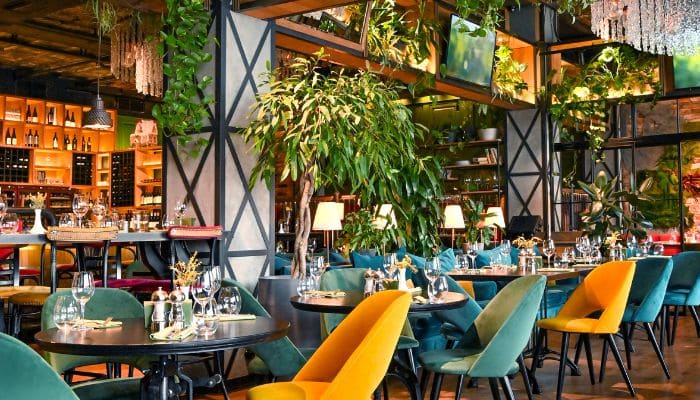9 Fresh Ways to Green Your Restaurant in 2024
Nowadays, everyone is interested in green business, whether promoting operational or consumer sustainability. Hospitality is no different. Creating an eco-friendly restaurant has many benefits, and owners will reap the benefits of energy and budget savings.
Here are nine fresh ways to make your eatery greener this year.
- Create an On-Site Garden
If you have the space, why not create a chef’s garden for the freshest ingredients? Several restaurants have constructed land-based or rooftop gardens where they grow seasonal fare for their recipes.
For instance, Sierra Mar in Big Sur, California, has a chef’s garden from which they pull produce for their organic menu. Napa Valley’s renowned The French Laundry has also maintained its private culinary garden since 1978 and has delivered farm-to-table items since 1994.
- Work With Sustainable Suppliers
If sustainability is a priority for your establishment in 2024, an excellent place to start is your supply chain. Where and from whom does your restaurant source its products?
Ask your suppliers about their initiatives and decide whether their operations align with your efforts to go green. If not, encourage them to adopt greener principles or network with other companies to reach your sustainability goals. Your questioning might be the push they need to start transforming their own operations.
- Source Locally-Grown Ingredients
Carbon emissions from food miles are much higher than most experts perceived. According to a 2022 study, the transportation of produce contributes 36% of food-based emissions, releasing twice as many greenhouse gasses as its production.
Reduce your restaurant’s carbon footprint by purchasing fresh fruits and vegetables from local farms. Supporting nearby sellers boosts the local economy and limits the emissions your restaurant contributes through food transportation. Likewise, you might grow herbs and spices to make unique flavor combinations and seasonings.
- Launch Meatless Mondays
Cows produce ample methane gas — a significant contributor to global warming. Even one day of avoiding selling steaks and ribeye at your eatery makes a difference in the fight against climate change. Likewise, swapping out meat items can help your restaurant save money, as animal product costs have reached all-time highs.
- Use Eco-Friendly Packaging
Packaging makes up a lot of restaurant and consumer waste. Consider swapping out conventional food containers for eco-friendly alternatives, such as the following:
- Recyclable: Plastic made from recycled plastic or paper, capable of being recycled again
- Compostable: Made from natural materials like sugarcane or bamboo, breaking down into compost for the garden
- Biodegradable: Made from disintegrating materials like bioplastics and plant-based products
- Reusable: Sturdier plastic products patrons can use again, such as the soup containers you get from Chinese food
Some restaurants even offer discounts to customers who bring their own to-go containers or coffee cups from home.
- Start a Composting Program
If you’re unsure what to do with leftover food scraps, consider composting the organic materials. You can then use it in your on-site garden, or share it with community gardens and local farmers.
Establishments with limited space for a composting bin or who can’t meet the necessary regulations may also use a haul-away service. These enterprises retrieve organic waste from your restaurant and bring it to another site for composting.
- Install Energy-Efficient Fixtures
Light-emitting diodes (LEDs), smart thermostats, low-flow faucets and toilets, and eco-friendly air dryers are just some of the energy-efficient fixtures you might install in your green eatery. In fact, LEDs generate 75% less energy than incandescent bulbs and last 25 times longer, meaning you’ll save money and reduce waste.
Although you can probably swap out the LEDs independently, you may need to hire an installer to enhance your restaurant’s plumbing and electrical systems for better energy use. Overall, you’ll improve your restaurant’s sustainability and overhead in the long term.
- Use Digital Menus
Converting to a digital menu can reduce paper consumption and waste. In addition to using a website or smartphone app, restaurants can use the latest modalities like tabletop tablets and QR codes.
Set tablets on each table for customers to browse your offerings. Depending on the technology, they may be able to order and pay for their meals from the device. Likewise, you can place a QR code for customers to scan to pull up the online menu with their phones. According to one survey, 45% of patrons used QR codes to view menus during the year as of June 2023.
- Partner With Local Initiatives
Whatever your restaurant’s sustainability goals are, try to align them with those of your community. For example, support nonprofit organizations, community gardens and schools in the area to promote sustainability locally.
You might donate a portion of your profits to an urban agriculture group or host sustainable cooking seminars for the public. Likewise, you could affiliate the restaurant with local farms or farmers markets.
Green Your Restaurant for a Healthier Planet
Making your restaurant more sustainable may not seem like a significant improvement for the planet, but every effort counts. Owning a green establishment may also appeal more to diners who share your vision for a healthier environment.
Take strategic steps to embrace eco-friendliness at your eatery and watch it prosper.



Comments are closed.